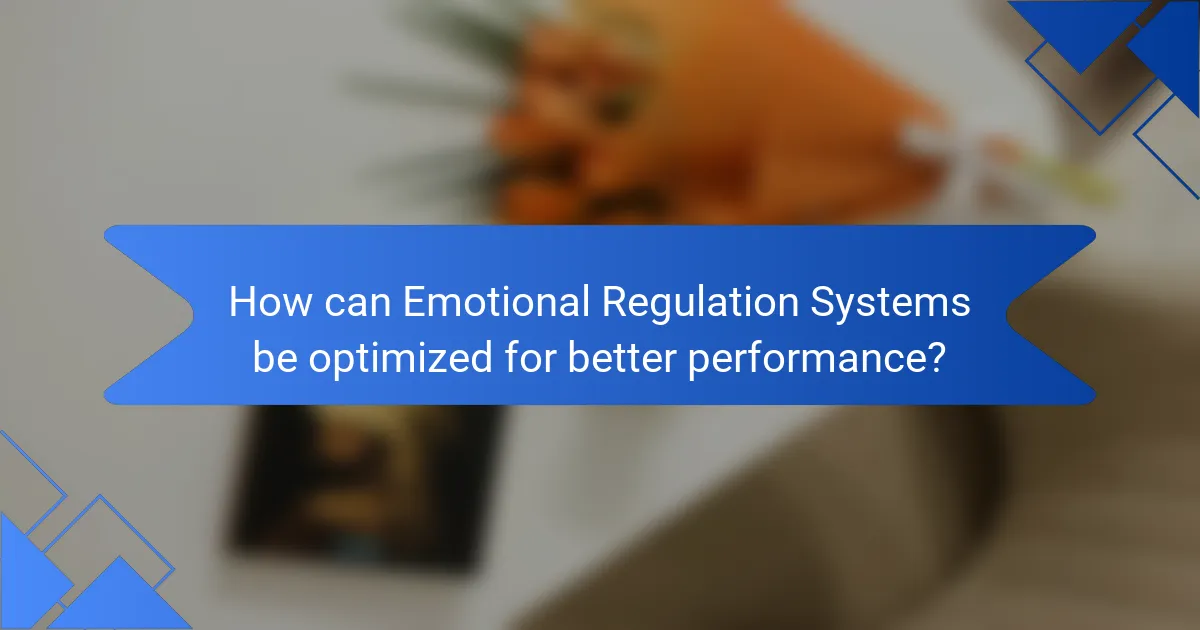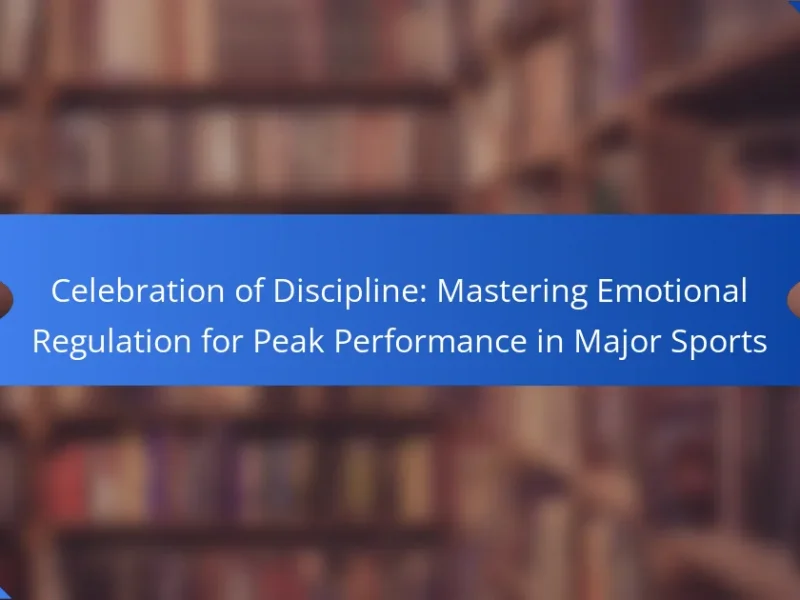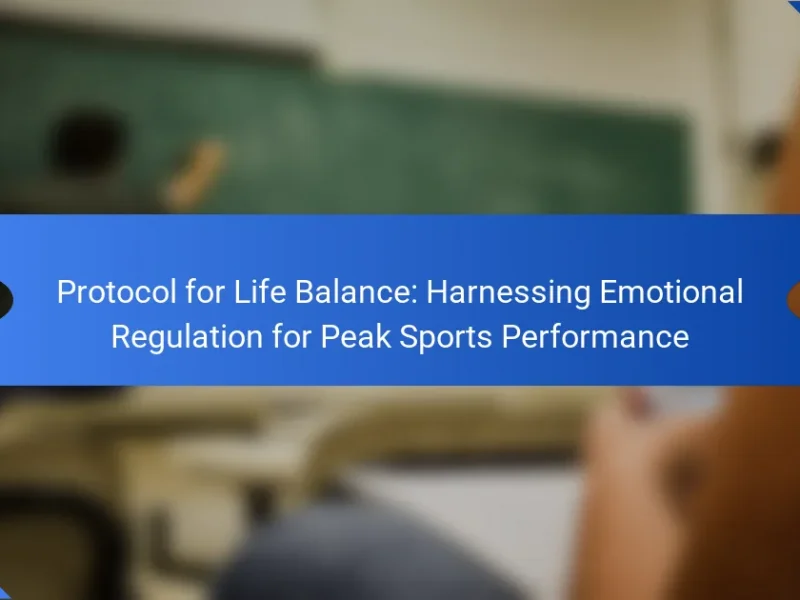Emotional regulation systems are vital for optimizing athlete performance in major sports. This article explores how these systems enhance focus and resilience, the universal and unique attributes that differentiate sports contexts, and the challenges athletes face in high-pressure situations. It also discusses structured training techniques like mindfulness and cognitive restructuring that can improve emotional management and performance metrics.

What are Emotional Regulation Systems in Major Sports?
Emotional regulation systems in major sports are crucial for optimizing athlete performance. These systems encompass strategies that athletes use to manage their emotions under pressure, leading to enhanced focus and resilience. Effective emotional regulation can differentiate high-performing athletes from their competitors. Research shows that athletes who utilize cognitive reappraisal techniques experience lower anxiety levels and improved performance metrics. Additionally, emotional intelligence plays a unique role, allowing athletes to recognize and respond to their emotions effectively, contributing to overall success in competitive environments.
How do Emotional Regulation Systems impact athlete performance?
Emotional regulation systems significantly enhance athlete performance by managing stress and optimizing focus. These systems enable athletes to maintain composure under pressure, leading to improved decision-making and execution. Research indicates that athletes with strong emotional regulation skills experience reduced anxiety levels, which correlates with higher performance metrics. Additionally, these systems foster resilience, allowing athletes to recover quickly from setbacks, further boosting overall performance levels.
What are the key components of Emotional Regulation Systems?
Emotional regulation systems in sports performance consist of awareness, strategies, and feedback mechanisms. Awareness involves recognizing emotional states that affect performance. Strategies include cognitive reframing and mindfulness techniques to manage emotions. Feedback mechanisms assess emotional responses and their impact on performance outcomes. These components collectively enhance athletes’ ability to maintain focus and resilience during competition.
What role do emotions play in sports performance?
Emotions significantly influence sports performance by affecting athletes’ focus, motivation, and resilience. Emotional regulation systems help athletes manage stress and anxiety, enhancing performance under pressure. Research indicates that positive emotions correlate with improved outcomes, while negative emotions can hinder performance. Effective emotional regulation strategies, such as mindfulness and visualization, are unique attributes that contribute to an athlete’s success in high-stakes environments.
How do athletes typically manage their emotions during competition?
Athletes manage their emotions during competition through techniques like visualization, self-talk, and mindfulness. These strategies help maintain focus and regulate stress levels. Visualization allows athletes to mentally rehearse performance scenarios, enhancing confidence. Self-talk serves as a motivational tool, reinforcing positive beliefs and reducing anxiety. Mindfulness practices, such as deep breathing, help athletes stay present and calm under pressure. These emotional regulation systems are crucial for optimal performance in high-stakes environments.

What are the universal attributes of Emotional Regulation Systems?
Emotional Regulation Systems in major sports performance share universal attributes such as awareness, flexibility, and resilience. Awareness enables athletes to recognize their emotions, while flexibility allows them to adapt their responses to varying situations. Resilience helps athletes recover from setbacks and maintain focus. These attributes collectively enhance performance under pressure, fostering a competitive edge.
How do common strategies for emotional regulation manifest in sports?
Common strategies for emotional regulation in sports include mindfulness, cognitive restructuring, and emotional expression. Mindfulness enhances focus and reduces anxiety, improving performance under pressure. Cognitive restructuring helps athletes reframe negative thoughts, promoting a positive mindset. Emotional expression allows athletes to process feelings, fostering team cohesion and mental resilience. These strategies collectively enhance performance by optimizing mental states during competition.
What psychological theories support emotional regulation in sports?
Cognitive-behavioral theory and emotional intelligence theory support emotional regulation in sports. Cognitive-behavioral theory emphasizes the role of thoughts in emotional responses, enabling athletes to reframe negative emotions. Emotional intelligence theory highlights the importance of recognizing and managing emotions, fostering resilience in high-pressure situations. These theories enhance performance by promoting focus, reducing anxiety, and improving decision-making under stress.

What unique attributes differentiate Emotional Regulation Systems in various sports?
Emotional Regulation Systems in various sports differ primarily in their unique attributes, such as coping strategies, intensity control, and focus techniques. For instance, team sports often emphasize collective emotional management, fostering group cohesion. In contrast, individual sports may prioritize personal strategies, enhancing self-awareness and resilience. Athletes also adapt their emotional responses based on the sport’s demands; high-contact sports require quicker emotional regulation than precision sports. These variations highlight the unique attributes that shape emotional regulation across different sporting contexts.
How do team sports differ from individual sports in emotional regulation?
Team sports foster collective emotional regulation through shared experiences, while individual sports emphasize personal emotional control. In team settings, athletes develop resilience and coping mechanisms through social interactions and support. This unique attribute enhances motivation and reduces anxiety, leading to improved performance. Conversely, individual sports require athletes to rely on self-regulation techniques, which can lead to heightened pressure and stress. As a result, emotional regulation strategies differ significantly, influencing overall performance outcomes in both contexts.
What role does coaching play in shaping emotional regulation strategies?
Coaching significantly enhances emotional regulation strategies in athletes by providing tailored support and feedback. Coaches help athletes identify triggers and develop coping mechanisms, fostering resilience. This relationship is vital in high-pressure environments, enabling athletes to maintain focus and composure. Emotional intelligence cultivated through coaching can lead to improved performance outcomes and overall well-being.

What are the rare attributes associated with Emotional Regulation Systems?
The rare attributes associated with Emotional Regulation Systems in major sports performance include advanced cognitive flexibility, unique resilience patterns, heightened empathy in team dynamics, and atypical stress response mechanisms. These attributes contribute to athletes’ ability to manage emotions effectively under pressure.
What uncommon emotional regulation techniques are used by elite athletes?
Elite athletes employ uncommon emotional regulation techniques like visualization, mindfulness, and biofeedback. Visualization helps athletes mentally rehearse performance, enhancing focus and reducing anxiety. Mindfulness practices cultivate present-moment awareness, improving emotional resilience under pressure. Biofeedback provides real-time data on physiological states, allowing athletes to regulate stress responses effectively. These techniques contribute to superior performance by optimizing emotional states and enhancing mental clarity.
How do cultural factors influence emotional regulation in sports?
Cultural factors significantly shape emotional regulation in sports by influencing athletes’ responses to stress and competition. Different cultures emphasize various emotional expressions, impacting how athletes manage their feelings during performance.
For instance, collectivist cultures may promote emotional restraint, leading to a more subdued approach in high-pressure situations. In contrast, individualistic cultures might encourage open emotional expression, fostering a more aggressive competitive spirit.
Research indicates that athletes from cultures with strong emotional regulation norms often perform better under pressure. This suggests that understanding cultural backgrounds can enhance coaching strategies and improve athlete performance.
Ultimately, cultural factors serve as a unique attribute in emotional regulation systems, affecting not only individual athletes but also team dynamics and overall sports performance.

What challenges do athletes face in regulating emotions during critical moments?
Athletes face significant challenges in regulating emotions during critical moments, including pressure, anxiety, and self-doubt. These emotional hurdles can lead to impaired decision-making and performance. High-stakes situations trigger physiological responses that complicate emotional management. For example, increased heart rate can hinder focus. Developing emotional regulation skills is crucial for maintaining composure and enhancing performance under pressure. Techniques such as mindfulness and visualization can help athletes better cope with these challenges.
How can athletes prepare for high-pressure situations?
Athletes can prepare for high-pressure situations by developing emotional regulation strategies. Techniques such as mindfulness, visualization, and controlled breathing enhance focus and resilience. Practicing these methods in training fosters adaptability during competition. Research shows that athletes using emotional regulation techniques improve performance under stress, demonstrating the unique attribute of mental preparedness.
What are the consequences of poor emotional regulation in sports?
Poor emotional regulation in sports can lead to performance decline, increased stress, and interpersonal conflicts. Athletes may experience anxiety, reduced focus, and impulsive decisions, negatively impacting their game. For instance, studies show that emotional dysregulation correlates with higher rates of burnout and decreased satisfaction in athletes. As a result, teams may face challenges in cohesion and overall performance.

How can Emotional Regulation Systems be optimized for better performance?
To optimize Emotional Regulation Systems for better performance, athletes should implement structured training techniques. These techniques include mindfulness practices, cognitive restructuring, and biofeedback. Mindfulness enhances awareness of emotional states, allowing for better control. Cognitive restructuring helps athletes reframe negative thoughts into positive ones, fostering resilience. Biofeedback provides real-time data on physiological responses, aiding in emotional management. Each of these methods targets unique aspects of emotional regulation, ultimately improving overall sports performance.
What best practices can athletes adopt for effective emotional regulation?
Athletes can adopt several best practices for effective emotional regulation, including mindfulness techniques, structured routines, and cognitive reframing. Mindfulness practices help athletes stay present and manage stress. Structured routines provide a sense of control, while cognitive reframing allows for a positive interpretation of challenges. These strategies enhance performance and mental resilience.
What common mistakes should athletes avoid in emotional regulation?
Athletes should avoid common mistakes in emotional regulation, such as ignoring emotions, overreacting to setbacks, and lacking coping strategies. Recognizing and addressing emotions is crucial for performance. Overreactions can lead to poor decision-making during competitions. Implementing effective coping strategies, like mindfulness and visualization, enhances emotional control.
What expert insights can enhance understanding of emotional regulation in sports?
Expert insights into emotional regulation in sports reveal that athletes can enhance performance through effective emotional management strategies. Techniques such as mindfulness, cognitive restructuring, and self-talk have shown significant benefits. For example, mindfulness training can reduce anxiety and improve focus during high-pressure situations. Research indicates that athletes who practice these techniques report enhanced emotional resilience, leading to improved performance metrics. Additionally, understanding the unique emotional triggers in various sports can help tailor regulation strategies effectively.


